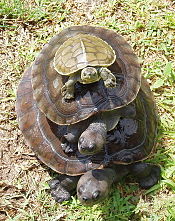Beale's eyed turtle
| Beale's eyed turtle | |
|---|---|
| Scientific classification | |
| Domain: | Eukaryota |
| Kingdom: | Animalia |
| Phylum: | Chordata |
| Class: | Reptilia |
| Order: | Testudines |
| Suborder: | Cryptodira |
| Superfamily: | Testudinoidea |
| Family: | Geoemydidae |
| Genus: | Sacalia |
| Species: | S. bealei
|
| Binomial name | |
| Sacalia bealei (Gray, 1831)
| |
| Synonyms[3] | |
| |
Beale's eyed turtle (Sacalia bealei) is a species of turtle in the family Geoemydidae (formerly Bataguridae). The species is endemic to China.
Description
S. bealei has a yellowish-brown, smooth, rather depressed carapace spotted with black, and it has an olive-green head. Another form of this species has a brown carapace. In both forms, there are two pairs of black-centered ocelli on the back of the head which is peppered with black spots. This is a turtle of moderate size and will grow up to a maximum straight-line carapace length of 18 cm (7 inches).[4]
Habitat
A nocturnal species, S. bealei lives in mountain streams at all elevations, but with a preference for heavily forest-covered streams with many large stones so as to provide shelter.[4]
Diet
S. bealei feeds on crayfish and worms, and accepts meat in captivity.[4]
Behavior
A timid and nervous species, S. bealei will scramble and flail wildly with its claws when handled.[4]
Reproduction
S. bealei is reported to lay 6 eggs at a time.[4] The nests are often half-buried by leaves and soil, and the entire nesting process may take up to 165 minutes.[5]
Common names
S. bealei is sometimes called Beale's four-eyed turtle, though that is not an ideal
Etymology
The specific name, bealei, is in honor of Thomas Beale, a Scottish naturalist and merchant in China.[6]
Geographic range
S. bealei occurs throughout the provinces of central and Southern China. It is considered very rare in Hong Kong.[4]
Conservation status
Listed as
References
- ^ IUCN Red List of Threatened Species 2020: https://dx.doi.org/10.2305/IUCN.UK.2000.RLTS.T19796A9016239.en. Downloaded on 21 June 2021.
- ^ "Appendices | CITES". cites.org. Retrieved 2022-01-14.
- ISSN 1864-5755.
- ^ ISBN 962-7849-05-7.
- ^ PMID 29963334.
- ISBN 978-1-4214-0135-5. (Sacalia bealei, p. 20).
- ^ da Nóbrega Alves et al. (2008)
- ^ "香港爬蟲協會 - 香港受保護野生動物". www.hkras.org. Retrieved 2020-11-07.
- ^ "Beal's Four Eyed Turtle – Sacalia bealei ". HongKongSnakeID.com. Retrieved 2020-11-21.
Further reading
- Boulenger, George Albert. (1889). Catalogue of the Chelonians, Rhynchocephalians, and Crocodiles in the British Museum (Natural History). New Edition. London: Trustees of the British Museum (Natural History). (Taylor and Francis, printers). x + 311 pp. + Plates I- VI. ("Clemmys bealii [sic]", p. 107).
- da Nóbrega Alves, Rômulo Romeu; da Silva Vieira, Washington Luiz; Gomes Santana, Gindomar. (2008): "Reptiles used in traditional folk medicine: conservation implications". Biodiversity and Conservation 17 (8): 2037–2049. (HTML abstract, PDF first page)
- Gray, John Edward. (1831). Synopsis Reptilium; or Short Descriptions of the Species of Reptiles. Part I.—Cataphracta. Tortoises, Crocodiles, and Enaliosaurians. London: Treuttel, Wurtz, and Co. viii + 85 pp. ("Cistuda Bealei ", p. 71).


